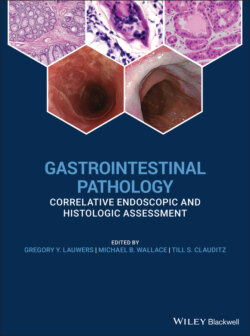Читать книгу Gastrointestinal Pathology - Группа авторов - Страница 48
Herpes Simplex (HSV)
ОглавлениеIf HSV infection is suspected, in addition to biopsies for histology, fresh tissue can be sent for viral culture to confirm the diagnosis and identify strains that may be resistant to acyclovir. HSV infection is associated with ulceration and a mixed inflammatory infiltrate of intraepithelial neutrophils, eosinophils, and lymphocytes, as well as aggregates of macrophages that can be a diagnostic clue. HSV infects squamous cells of intact or denuded epithelium and is best identified at the edge of an ulcer and in cells within the ulcer slough. Therefore, optimal histologic diagnosis requires sampling of the ulcer edge rather than the ulcer bed. The typical viral cytopathic effects include multinucleation, ground glass nuclei, and dense intranuclear eosinophilic inclusions with a thickened nuclear membrane and a clear halo (Cowdry type A inclusion bodies) (Figure 2.6). Viral inclusions and multinucleated cells are not always identifiable in biopsies, and ancillary immunohistochemistry (IHC) staining for HSV may be required. Concomitant infection of Candida, cytomegalovirus, or bacteria can exist, particularly in immunocompromised patients. Varicella Zoster Virus has been associated with esophagobronchial fistula formation.
